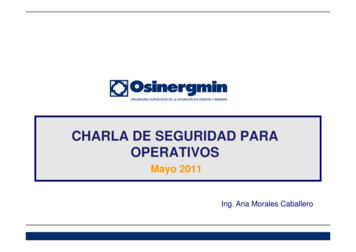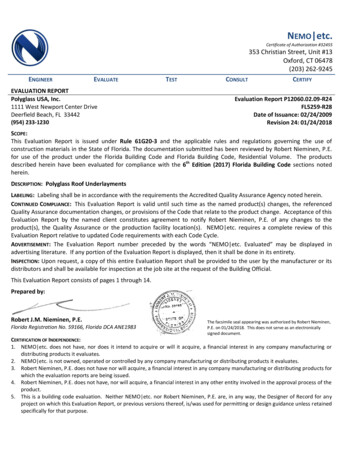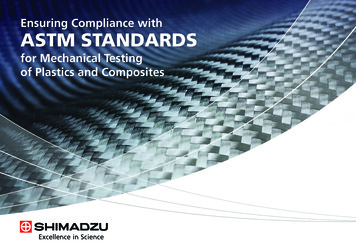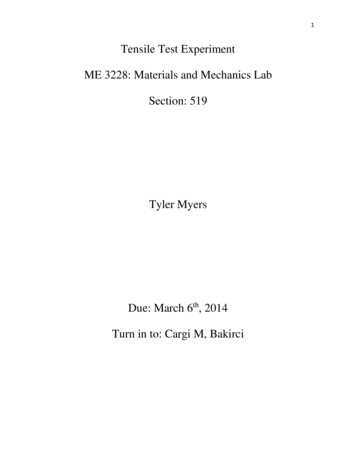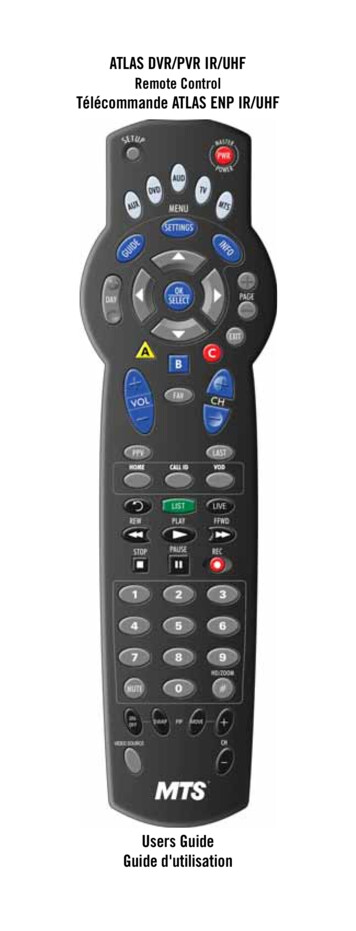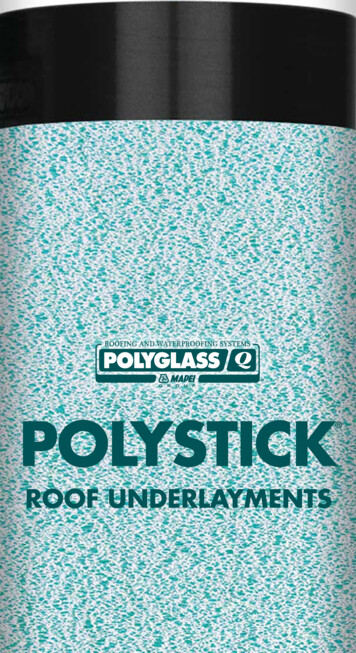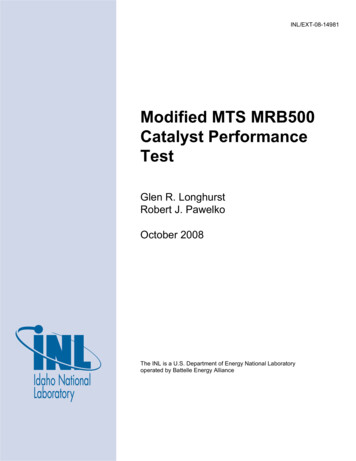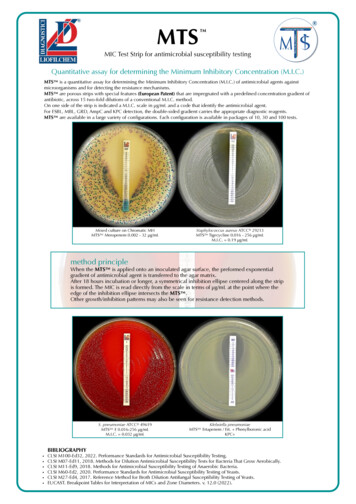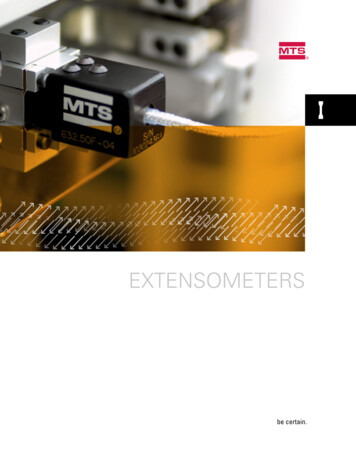
Transcription
lEXTENSOMETERSbe certain.
E X T E N SO METER S ARE U SED FOR ME ASURING AND/ OR CONT ROLLINGS T R A I N I N TEN SI O N , COMPRESSION AND FAT IGUE T E ST ING AP P LICAT IONS.M E A SURI N G ON THE SPECI ME N SIGNIFICANT LY INCRE ASE S T HE RE LIABILIT YO F Y OU R DATA . RELYI N G ON T HE CROSSHE AD OR ACT UAT OR MOVE ME NTO F Y OU R M ATERI ALS TEST SY ST E M W ILL ME ASURE T OO MUCH – MACHINEDEFLECTION, GRIP DEFLECTION, AND POSSIBLE SLIPPAGE ARE ALL CAPTUREDI N T H E LO A D TRA I N DI SPLA CE ME NT ME ASURE ME NT.Extensometer Table of ContentsIntroductionExtensometer Application IndexExtensometer Functional Index6 Things to Remember when Selecting an ExtensometerAxial ExtensometersHigh Temperature ExtensometersSpecialty ExtensometersMTS Advantage Video ExtensometerLaser ExtensometerOther ApplicationsClip-On Displacement GagesDisplacement GagesExtensometer CalibratorMTS Direct Current Potential Drop (DCPD) Solution3456-910-2324-2627-3132-33343536373839
ExtensometersAccuracy is KeyPioneered to PerfectionMTS pioneered and perfected the cross-flexuredesign that ensures true center point bending of itsextensometers. Precision, resistive-type foil straingages are bonded to the MTS cross-flexure to forma 4-arm fully active Wheatstone bridge.»» Small, lightweight design – most are under 35 g mass»» MTS extensometer models are available for both staticand dynamic testing»» Bridges of 350 ohms and 1000 ohms are used»» MTS extensometers meet or exceed requirements forcalibration according to ASTM E83 Class B1 and ISO9513 Class 0.5 standards»» Output, depending on the unit is 2 mV/V to 6 mV/VCAN’T FIND WHAT YOU NEED?»» Nominal excitation range from 5 to 12 V DC for roomtemperature testing»» Our extensometer portfolio contains hundreds andhundreds of additional dynamic rated extensometers.Contact your local sales representative or applicationsengineer to find the model that meets your exact needsHIGH PERFORMANCE, HIGH QUALITY»» Proven stability over 30 years of usage»» Built-in over-travel protection provides repeatableaccurate data from test initiation through specimenfailure»» Quickly and accurately set-up your extensometerusing the zero set pin or zero stop»» Cross-flexure design ensures the strain gages aresubjected to true center point bending and the sameforce, time after timeMTS has the broadest selection of extensometry in the world»» Custom models are also available upon requestMTS Extensometer Repair & ReworkWhy go through the process of certifying a newextensometer when the one you have still does the job?Many of our extensometers survive tens of thousands oftests without a problem – so if the unit only needs a newzero set pin or cables let us repair it for you. Contact yourlocal sales representative for details.3
Extensometer Application IndexUse this helpful index to determine which extensometersare best suited for your application. If the extensometerlisted is in blue, it is not shown in this catalog.Please contact us for more information.ApplicationExtensometer OptionsMetalsTensile (ASTM E8)632.13/.24 & 634.11/.12/.25/.28/.31; 635; AVX; FAXSee Pages11, 12, 14, 15, 16, 19, 21, 32Compression (ASTM E9)632.13/.26/.27 & 634.11/.12/.31KIC - Fracture Toughness (ASTM)632.02 ASTM Standard; 632.03 MTS Enhanced; 632.65 (High Temperature)Pre-Cracking (ASTM E399)632.05 (High Frequency)JIC (ASTM E813)632.03 with Long Travel Option36Crack Growth - Bend (ASTM E399)632.0336Fatigue Crack Growth (ASTM E647)632.03 with Long Travel Option; 632.05 (High Frequency)36High Cycle Fatigue632.27 (Low Strain)Low Cycle Fatigue (ASTM E606)632.13/.18/.19/.20 & 634.11/.12/.31 & 632.50/.51/.53/.54Low Cycle Fatigue (High Temp)632.50/.51/.5224, 25, (please call for .52)Low Cycle Fatigue (High Temp)632.53/.5424Advanced MaterialsBend (MIL SPEC 1942, JIS 1601R)11, 12, 13, 1636please call1311, 12, 16, 24, 25, 30632.06; AVX32, 37Tensile/Compression632.26; AVX; FAX11, 21, 32High Temperature (CMC’s MMC’s)632.5X24, 25632.70please callTensile (ASTM D3039)632.17/.85 & 634.11/.31; AVX12, 16, 27, 28, 32Compression (ASTM D695)632.17 & 634.11/.31; AVX 45 Shear Test (ASTM D3518)632.17 & 634.11/.31Flexure (ASTM D790)632.06 & 634.11/.3112, 16, 37Tension/Tension Fatigue (ASTM D3479) 632.17/.85 & 634.11/.31Plastics12, 16, 27, 28Ultra High Temperature BendCompositesTensile (ASTM D638)632.17/.24/.85 & 634.12/.25/.31, 635, LX 500/1500; AVX; FAX; AHX 850Rock MechanicsTriaxial Comp. Strength (ASTM D2664)Triaxial Creep (ASTM D4406)632.90/.92632.90/.92Bio-Materials632.29 & 634.11/.12/.25/.31, LX 500; AVX; FAXAxial/Torsional632.68/.80High TemperatureAir Cooled12, 16, 27, 3212, 16, 2712, 14, 15, 16, 19, 2122, 27, 28, 32, 33, 34please callplease call10, 12, 14, 16, 21, 32, 34please call632.53/.5424Water Cooled632.51/.6825 (please call for .68)Uncooled632.53/.54/.7024632.10 & LX 500/150034Hostile EnvironmentsFracture MechanicsFracture Toughness632.02/.03; 632.6536Pre-CrackingBendDisplacement632.05 (High Frequency)Crack Growth632.0336High Temperature632.70please call632.06FractureCrack GrowthHigh CycleLow Cycle MechanicsLow Cycle (High Temp)632.03 with Long Travel Option; 632.05 & 632.65632.27 (Low Strain)632.13/.18/.19/.20 & n TestingTensileCompression632.13/.24 & 634.11/.12/.25/.28/.31; 635, AVX; FAX; AHX 850632.13/.26/.27 & 634.12/.25/.31; AVX; FAXPoisson’s Ratio632.18/.19/.20/.23/.85 & 634.12/.25/.31; AVX; FAXElastic Limit632.26/.27/.29please call37361311, 12, 16, 3024, 2511, 12, 14, 15, 16, 19, 21, 22, 3211, 12, 13, 16, 21, 3212, 14, 16, 21, 28, 29, 30, 3210, 11, 13
Extensometer Functional IndexAxial Contact ExtensometersDYNAMIC MODELS (TENSION/COMPRESSION)Metric UnitsUS Customary UnitsGA G ELENGTHM EASURING RANGE:STRAIN ( TRAVEL)GA GELE NGT HM E A SURING RA NGE :ST RA IN ( T RAVE L)S EEPA G E632.29F-203 mm 8% ( 0.24 mm)632.29E-200.12 in 8% ( 0.0096 in)10632.29F-305 mm-10%/ 30% (-0.5 mm/ 1.5 mm)632.29F-306 mm 4% ( 0.24 mm)632.29E-300.2 in-10%/ 30% (-0.02 in/ 0.06 in)10632.29E-3X0.24 in 4% ( 0.0096 in)10632.26F-3X8 mm632.26F-2X8 mm 6% ( 0.48 mm)632.26E-3X0.3 in 6% ( 0.018 in)11 15% ( 1.2 mm)632.26E-2X0.3 in 15% ( 0.045 in)632.13F-2X1110 mm 15% ( 1.5 mm)632.13E-2X0.5 in 15% ( 0.075 in)11632.26F-4X12 mm 9% ( 1.1 mm)632.26E-4X0.5 in 9% ( 0.045 in)11632.27F-3X25 mm 2% ( 0.5 mm)632.27E-3X1.0 in 2% ( 0.02 in)13632.27F-2X25 mm 4% ( 1.0 mm)632.27E-2X1.0 in 4% ( 0.04 in)13M O DE LN U MB E RM OD E LNUM BE R634.11F-2X25 mm 20%/-10% ( 5 mm/-2.5 mm)634.11E-2X1.0 in 20%/-10% ( 0.2 in/-0.1 in)12634.12F-2X25 mm 50%/-10% ( 12.5 mm/-2.5 mm)634.12E-2X1.0 in 50%/-10% ( 0.5 in/-0.1 in)12634.25F-2X50 mm 50%/-10% ( 25 mm/-5 mm)634.25E-2X2.0 in 50%/-10% ( 1.0 in/-0.2 in)14variable ( 4 mm/-2 mm)634.31E-2X0.5-2.0 invariable ( 0.2 in/-0.1 in)16634.31F-2X 10-50 mmMONOTONIC MODELS (TENSION ONLY)Metric UnitsUS Customary UnitsGA G ELE N G THM EASURING RANGE:STRAIN ( TRAVEL)635.25F-0525 mm 20% ( 5 mm)634.11F-5x25 mm 20% ( 5 mm)634.12F-5x25 mm632.24F-50635.50F-05M O DE LN U MB E RM OD E LNUM BE RGA GELE NGT HM E A SURING RA NGE :ST RA IN ( T RAVE L)634.11E-5X1.0 in 20% ( 0.2 in)12 50% ( 12.5 mm)634.12E-5X1.0 in 50% ( 0.5 in)1225 mm 100% ( 25 mm)632.24E-501.0 in 100% ( 1.0 in)1550 mm 10% ( 5 mm)634.25E-5X2.0 in 50% ( 1.0 in)14, 16634.28E-242.0 in 100% ( 2.0 in)15, 19S EEPA G E19635.50F-1050 mm 20% ( 10 mm)635.50F-2550 mm 50% ( 25 mm)19634.25F-5x50 mm 50% ( 25 mm)14634.28F-2450 mm 100% ( 50 mm)15635.100F-10100 mm 10% ( 10 mm)195
Typical material specimens
6 Things to Remember when Selecting an ExtensometerExtensometers are available in hundreds of models and multiple technologies,so selecting the correct one can be confusing. An easy way to remember therelevant criteria for extensometer selection is to think of the acronym S.T.R.A.I.N.SpecimenAlways start with the specimen. Knowing some specimenproperties before starting a test will help you select thebest test equipment.CONSIDER THE SPECIMEN’S CROSS-SECTIONAL AREAGage length extender kits modify the gage length of anexisting extensometer to perform strain measurementsat longer or shorter gage lengths.springs, rubber bands, or quick attachment kits. Look forlightweight extensometers that can be secured close tothe specimen. The weight and length of the extensometercreate an overturning movement that must be reacted toby the bottom knife edge. The knife edge on the bottomwill dig into the specimen and the knife edge on the topwill pull away. This problem worsens as gage lengthdecreases. Next, look for knife edges that are sharpenedon both sides – with a symmetrical point in the middle ofthe knife edge. These knife edges will last longer and areless likely to chip than asymmetrical options. Inexpensiveextensometers are often heavier and longer, and they aremore likely to bend the specimen or slip off.Whether the specimen is round or flat determineswhich type of knife edges to use with a contactextensometer. Straight knife edges are standard onIDENTIFY THE SPECIMEN’S GAGE LENGTHmany extensometers and recommended for testingExtensometer measurements are taken over the center round specimens. Knife edges with 3-point specimenof a tensile or fatigue specimen called the gage section. contact are typically used when testing flat specimens.They include one single-point and one double-pointTypical material specimens have enlarged ends orcontact knife edge. The 3-point specimen contactshoulders for gripping and a gage section with a smallercross-sectional area. The gage section is narrower than the creates a plane, ensuring that your extensometer isends to ensure that material deformation occurs along the in line with the axis of your test.length with a constant area cross section. Typically strain isTAKE SPECIMEN PROPERTIES INTO ACCOUNTmeasured over the middle 70-80% of the gage section.Gage lengths for contact extensometers typically rangeThe specimen must be strong enough to support the3mm (0.12 in) to 100 mm ( 4 in), with longer gage lengths weight of the extensometer. Most room temperatureavailable for specific applications like rebar testing.extensometers are attached to the specimen usingGage lengthextender kitPREDICT HOW YOUR SPECIMEN WILL FAILSTRAIN»» Specimen»» Test Method»» Range»» Atmosphere»» ISO/ASTM Calibration»» Non-contactIf you plan to test through specimen failure, be surethat your extensometer is up to the task. Manyextensometers can be left on the specimen throughfailure, but backlash from high energy breaks candamage the most robust extensometer designs.Consider removing the extensometer before failureor using a non-contact extensometer if your specimenwill break violently.7
6 Things to Remember when Selecting an ExtensometerTest MethodAtmosphereAfter considering the specimen, knowing your testmethod helps narrow down extensometer options.Consider special needs when testing in extremeenvironments.USE DYNAMICALLY RATED EXTENSOMETERS FOR STATICTESTS, BUT NOT VICE VERSAMOUNT THE EXTENSOMETER OUTSIDE YOUR FURNACENot all extensometers are rated for dynamic testing. Forexample, if the frequency of the test cycle matches thenatural frequency of the extensometer, the extensometercan begin to vibrate, increasing the noise in the strainmeasurement signal. Dynamically rated extensometersshould be designed with high natural frequencies to avoidvibration. When testing at very high frequencies look foran extensometer that is lightweight with short arms.Excellent dynamic extensometers use a cross-flexuredesign that was originally patented by MTS in the1970s. A cross-flexure design ensures that the straingages inside the extensometer are subject to truecenter point bending. Uniform stresses on the straingage increase the fatigue life of the gage and ultimatelythe entire extensometer. The cross-flexure design hasbeen employed by almost all dynamic extensometermanufacturers.It’s hard to find a contacting extensometer that willwork in a furnace above 540 C (1000 F). At thesetemperatures, the adhesives that attach the strain gageto the cross flexure start to fail and the test materialssoften. Instead of quick attachment kits or rubber bands,extensometers used for testing at high temperaturesare externally mounted with quartz or ceramic rods thatextend into the furnace.Mounting the extensometer outside of the furnacebehind a heat shield protects the strain gage fromthermal stress while still accurately measuring strain.Most models available include air- or water-coolingoptions. Water cooling is more effective at keepingthe extensometer’s sensing elements at a constanttemperature and reducing the noise and thermal drift inthe data measured. Some users also develop their own“homemade” heat shields to protect the extensometerfrom thermal drift in their outside environment.SAVE MONEY WITH STATIC ONLY EXTENSOMETERSExtensometers used solely for static testing do notrequire the fatigue life of a dynamic extensometer. Forexample, a strain-gaged element that acts as a singlecantilever beam is cheaper than a cross-flexure designbecause there are fewer components. The disadvantageis that there is more stress at the root of the beam andthe bond holding the strain gage to the beam may wearout. Extensometers designed for static testing mayhave longer arms and are more likely to vibrate duringdynamic testing.RangeESTIMATE HOW LONG YOUR SPECIMEN WILL TRAVELTO IDENTIFY YOUR MEASUREMENT RANGEMeasurement range is the maximum travel anextensometer can stretch and still achieve accurateresults. Measurement range is indicated either by anabsolute measurement of distance or a relativemeasurement of strain range compared to the gagelength. For example, a 50 mm gage length extensometerwill have a measurement range of 10% or 5 mm.Most premium contacting extensometers are designedwith an over-travel protection that allows the device toextend slightly longer than its rated measurement rangewithout damaging the components.Extensometer mounted outside furnaceDON’T LET YOUR ROOM TEMPERATURE EXTENSOMETERGET TOO COLDAt extremely l
Compression (ASTM E9) 632.13/.26/.27 & 634.11/.12/.31 11, 12, 13, 16 KIC - Fracture Toughness (ASTM) 632.02 ASTM Standard; 632.03 MTS Enhanced; 632.65 (High Temperature) 36 Pre-Cracking (ASTM E399) 632.05 (High Frequency) please call JIC (ASTM E813) 632.03 with Long Travel Option 36 Crack Growth - Bend (ASTM E399) 632.03 36
